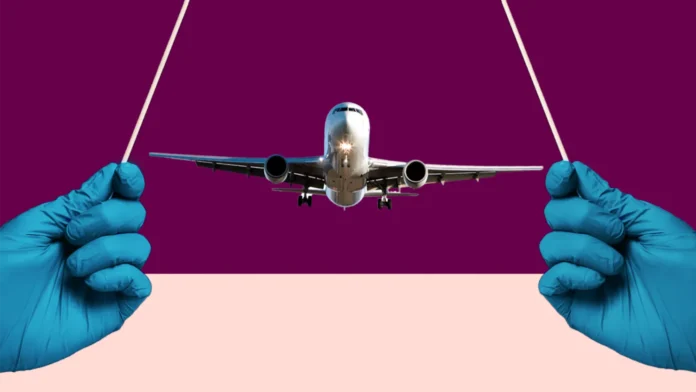The United States has lifted the order requiring travelers to show a negative test result or proof of recovery from covid-19 before entering the country. The change went into effect Sunday.
The news was welcomed by the travel industry, which has been pushing for an end to testing rules that they said discouraged foreign visitors from coming to the country and kept some Americans at home.
But health experts warn coronavirus risks remain. New cases, hospitalizations and deaths rose in the United States over the past week, although they remain far below the omicron variant peak earlier this year, according to Washington Post data. Now that international travelers aren’t required to test to get into the country, should they still consider testing? We asked health experts.
Why did the United States end the testing requirement?
The Centers for Disease Control and Prevention said the inbound testing requirement — in place since January 2021 — was necessary at the time, but the pandemic “has now shifted to a new phase.”
Citing the distribution of coronavirus vaccines, availability of therapeutics and the rate of vaccine- and infection-induced immunity, the agency said there’s now a lower risk of severe disease and death.
The CDC said it will reassess the decision in 90 days and reinstate the rule if necessary.
[Let By The Way help you navigate travel dilemmas]
Are there any U.S. travel restrictions still in place?
Not for Americans or residents. Non-U.S. citizens arriving by air must provide proof of vaccination to enter the country. However, according to the CDC website, “some categories of noncitizen, nonimmigrants are excepted from this requirement.”
What do health experts think of the change?
Experts were not surprised to see officials drop the rule, though some said they wished the United States were taking more public health precautions.
In a perfect world, Jayne Morgan, a cardiologist and executive director of the covid-19 task force at Piedmont Healthcare, said testing would be required for all flights — domestic and international. She’d also like to see universal masking in confined, public spaces.
But given we’re not living in a perfect world, “I think lifting these international travel regulations makes sense because we’re not enforcing anything else,” Morgan said.
To Brian C. Castrucci, the president and chief executive of the de Beaumont Foundation, a public health charity, the international testing requirement was “like blocking one hole in the colander — the water still gets out,” he said. “If we were continuing to enact a comprehensive prevention and mitigation strategy, then continuing that requirement makes sense.”
Gigi Gronvall, a senior scholar at the Johns Hopkins Center for Health Security, said in an email that it was “inevitable” that the testing order would be lifted because so many other countries have dropped their own rules. She said getting proof of a negative test was “burdensome and expensive” and that the United States has plenty of people infected within its borders.
But Robert Quigley, global medical director of health and travel security firm International SOS, cautioned travelers not to drop their guard.
“It’s important to note that while this mandate is lifted right now, the CDC is closely monitoring for a spike in cases, and it can be put back in place at any moment,” Quigley said in an email. “So, it’s prudent for travelers to play their part and still get tested when indicated and to avoid traveling while sick.”
Should travelers still test?
Despite the rule ending, the CDC still recommends testing as close to your travel day as possible (ideally within three days or less of your trip). If you test positive, don’t travel.
For international trips, Quigley said all travelers should test as a precaution. They should also be up to date on vaccinations and informed about local requirements for entering and leaving their destination.
“Having a negative PCR test with ready access to the result will only ensure smooth travel, especially in the event the order is put back into place while you’re traveling,” he said.
People should test if they were known to be exposed or have symptoms, Gronvall said.
Castrucci said to keep testing on the table not only for yourself, but for anyone vulnerable you’re coming home to, such as unvaccinated children, people who are immunocompromised or elderly family members.
Quigley said travelers should also get a coronavirus test within three days of return back to their home country.
[Pride is back — and more expensive than ever]
What kind of test should people take?
Quigley recommended a PCR test because it tends to be more accurate and is accepted more widely. It’s best for someone who has been exposed or has symptoms to take a PCR test, he said. But at the minimum, he recommended taking a rapid home test before getting on a plane.
Gronvall said rapid home tests are easy to bring along during a trip, as she was doing during domestic travel Monday.
[Biden’s revised Cuba policy creates more options for U.S. travelers]
What should you do if you test positive abroad?
International travelers who test positive during their trip should follow local rules, which vary by country, Quigley said. They should also find a local health-care provider who can assess when they’re no longer contagious.
[You asked: Where can I find a coronavirus test in a foreign country?]
Amanda Kobokovich, managing senior analyst at the Johns Hopkins Center for Health Security, said in an email that the CDC recommends people delay travel and isolate for 10 days regardless of vaccination status if they test positive in another country.
She said anyone who tests positive on a foreign trip should check the country’s policies for health care and isolation, because not all hotels can serve as isolation facilities.
Are there other ways travelers can protect themselves?
Morgan said it’s important to keep up with coronavirus mitigation efforts not only to avoid getting sick, but also to limit the virus’s potential to further evolve.
“The fact remains that the more infections that we have, the greater the risk we may have of a future variant that could be more formidable,” she said.
She recommended travelers continue to wear a mask indoors, particularly if they live in or are visiting a place that’s shaded red or orange on the CDC’s coronavirus maps.
Castrucci also recommended travelers continue to “do everything they can do to mitigate their personal risk, which includes testing,” he said, as well as strategies like masking and choosing to dine outdoors. “Just because the government has chosen to no longer prioritize covid prevention doesn’t mean that we need to stop.”












